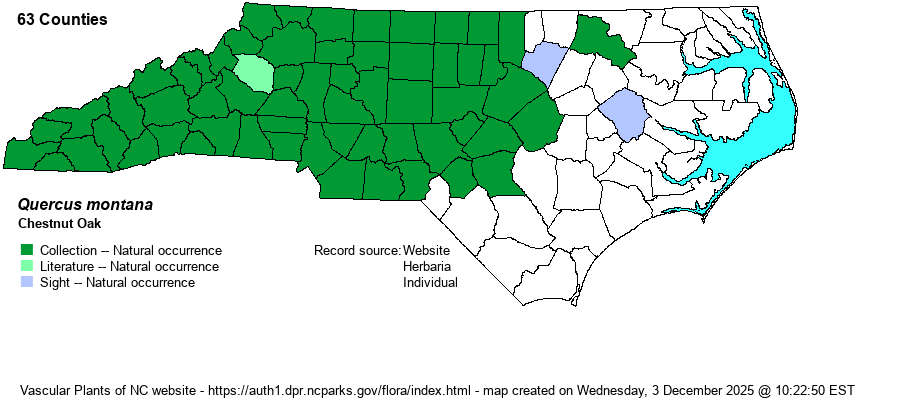| Author | Willdenow | |
| Distribution | Throughout the Mountains and the Piedmont, though perhaps absent in a few northeastern counties (east of Granville and Wake); a known disjunction eastward at Medoc Mountain State Park in Halifax County. Found at a few local sites in the western Coastal Plain (i.e., Sandhills of Hoke County by Little River), but otherwise absent from this province.
This is an Eastern species, ranging from southern ME and southern MI, south to AL and MS; absent in FL. It is very rare in the Coastal Plain.
| |
| Abundance | Common to very common, and one of the dominant trees, in the Mountains and Piedmont foothills. Generally common, at least locally, in the central Piedmont (especially in the Uwharrie Mountains), but mostly uncommon or infrequent in the eastern Piedmont. Very rare in the western Coastal Plain, and far northeastern Piedmont. | |
| Habitat | This species favors rocky upland forests, in xeric conditions. It especially favors ridgelines, hilltops, and other sites on the higher parts of ranges. These sites are almost always in acidic soils, especially where quartzite rocks dot the ground surface. In many areas where it occurs, it is the dominant canopy tree, and several natural communities contain “Chestnut Oak” in the name. |
| Phenology | Flowers in April; fruits from September to November of the same year. | |
| Identification | This is a very well known, medium to fairly large deciduous tree. It ranges mostly to about 60-70 feet tall, though with a fairly broad trunk; the thin and rocky soil generally limits the height of any tree species to under about 80 feet. It can usually be identified by its bark consisting of strong vertical furrows, leaving a “ridge and valley” look to the medium gray bark. Similar species -– Swamp Chestnut Oak (Q. michauxii) and Chinquapin Oak (Q. muehlenbergii) -– have “smoother” or flatter bark that is more “plated” and not deeply furrowed. The leaves are mostly elliptical to slightly obovate, with many low and rounded lobes along the margins. Swamp Chestnut Oak leaves tend to be more obovate, and Chinquapin Oak leaves tend to be narrower and with more triangular (angular) lobes. The former species usually is found in rich wetland soils, and the latter always on high pH soils, though also often in rocky habitats. | |
| Taxonomic Comments | The species has often been named as Quercus prinus. Weakley (2018) gives the reason why the name Quercus montana now takes priority.
| |
| Other Common Name(s) | Rock Chestnut Oak, Rock Oak, Mountain Chestnut Oak. Note that “Chestnut Oak” is a nested name, as Q. michauxii has the usual common name of Swamp Chestnut Oak. Certainly, adding “Rock” to the name of Q. montana -– Rock Chestnut Oak -– would avoid confusion. For now, we leave the prevalent common name as Chestnut Oak, following that in most references/websites.
| |
| State Rank | S5 | |
| Global Rank | G5 | |
| State Status | | |
| US Status | | |
| USACE-agcp | UPL link |
| USACE-emp | UPL link |

